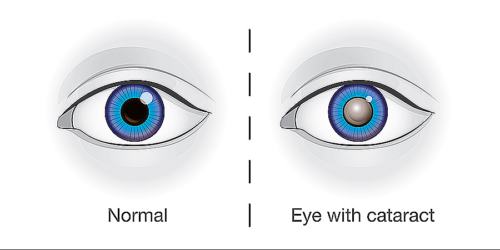How many times have you heard folks talking about cataracts but you didn’t know anything about the condition? Yet, the eye-related condition is more common than you think, According to the National Eye Institute by age 80 more than half of all Americans will either have a cataract or have had cataract surgery.
Inside the eye is a natural lens and it should be clear but when a cataract is present, it becomes cloudy and objects appear blurry, hazy, and less colorful.
Who gets cataracts?
As people age, there is a higher risk of developing cataracts but you don’t necessarily have to be elderly. Folks can have age-related cataracts in their 40’s and 50’s but during this time period, most do not affect vision. However, as soon as age 60 comes around, the eye condition will probably cause a few issues with vision.
People with certain risk factors are also more prone to get cataracts–diabetics, smokers, alcohol drinkers, and even those who expose themselves to ultraviolet light (UV) for extended periods of time. Some medical researchers also suspect that cataracts can be caused by the protein in the eye’s lens that just changes from natural wear and tear over the years.
Are there different types of cataracts?
There are four types of cataracts:
- Secondary cataract: can form after a surgical procedure for another eye issue like glaucoma
- Traumatic cataract: can develop even years after some kind of trauma to the eye
- Congenital cataract: some infants are born with cataracts or children can develop them sometimes in both eyes; vision might not always be affected because the cataracts are minuscule
- Radiation cataract: can spring up after exposure to radiation
How can cataracts be detected?
During a routine comprehensive eye exam, an eye care professional will be able to determine if someone has cataracts by performing one of the following three tests, although further exams might be needed:
- Visual acuity exam: used to determine how well you see the details of a letter or symbol from a specific distance
- Dilated eye exam: eyedrops are used to widen or dilate your pupils so that your eye care professional can view to the back of the eye, retina, and optic nerve, to check for signs of damage
- Tonometry: pressure inside the eyes is measured; the test is also used to screen for glaucoma
What kind of cataract treatment is required?
Early cataracts will probably not require anything more than just a new prescription for eyeglasses, magnifying glass, anti-glare sunglasses, or just brighter lighting. The only way to improve vision when a cataract is present is via surgery which involves removing the cloudy lens and replacing it with an artificial one or intraocular lens (IOL).
Cataracts are removed when they begin causing vision loss and everyday tasks like driving or watching TV are affected. They can also be removed if there is interference with another eye issue like age-related macular degeneration, or diabetic retinopathy.
If cataracts are present in both eyes, a physician will probably perform surgery on one eye at a time and schedule the procedures at least four weeks apart from each other. Cataract removal is a common procedure and can be effective. It is successful as far as vision improvement in about 90 percent of cases. There are some surgical risks involved with the surgery such as bleeding, double vision, high/low eye pressures, an infection that can lead to loss of vision, and an increase in the risk of retinal detachment.
There is a possibility that once someone has had cataract surgery their vision may become hazy again down the line. The blurriness occurs because the eye’s capsule, the part that holds the IOL in place has become cloudy. A physician can use a laser to open the cloudy capsule (capsulotomy) in order to bring clarity back to the eye.
Do make an informed decision and be sure to research and thoroughly discuss with a physician, any surgical procedure.
What to do once you’ve been diagnosed with cataracts?
- Have a comprehensive eye exam every two years if under age 65 and yearly, if older
- Wear shades to protect the eyes from damaging UV rays
- Kick the smoking habit to the curb
- Use a bright light to help you see better or consider using a magnifying glass
- Limit night driving once you begin to see halos or glare becomes an issue
- Make sure you have the right eyeglass prescription
